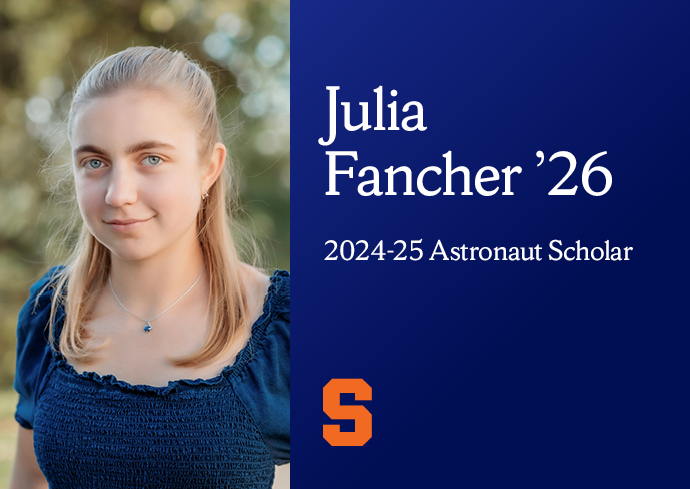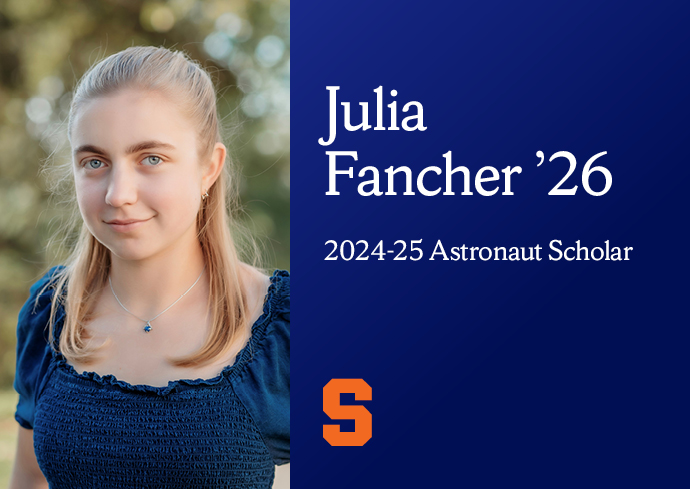
Julia Fancher, a rising junior majoring in physics and mathematics in the College of Arts and Sciences and a member of the Renée Crown University Honors Program, has been named a 2024-25 Astronaut Scholar by the Astronaut Scholarship Foundation (ASF).
Founded by the Mercury 7 astronauts, the foundation awards scholarships to students in their junior or senior year who are pursuing a science, technology, engineering or mathematics (STEM) degree with intentions to pursue research or advance their field upon completion of their degrees. Astronaut Scholars are among the best and brightest minds in STEM who show initiative, creativity and excellence in their chosen field.
The Astronaut Scholarship includes funding of up to $15,000 toward educational expenses, a paid trip to the ASF Innovators Week and Gala in Houston in August, where Fancher will receive the award, and lifelong mentoring and engagement opportunities with astronauts, Astronaut Scholar alumni, industry leaders and the ASF.
Fancher worked with the University’s Center for Fellowship and Scholarship Advising (CFSA) on her application. “Julia’s commitment to research in astrophysics since her first semester on campus at SU, combined with her extraordinary publication and presentation record, make her a superb fit for the Astronaut Scholarship,” says CFSA Director Jolynn Parker. “We’re thrilled that she’ll benefit from the program’s tuition support and excellent mentorship and professional development opportunities.”
“For 40 years, ASF has been at the forefront of nurturing the next generation of STEM leaders and fueling their passion for exploration and innovation,” says Caroline Schumacher, ASF president and CEO. “Each year, it’s thrilling to see the exceptional talent and dedication each new scholar brings to the ASF community. We welcome the 2024 class and look forward to supporting them in their quest to make their unique mark on our society.”
Fancher, who is also minoring in computer science in the College of Engineering and Computer Science, was recently named a 2024 Goldwater Scholar. When she was in middle school, her aunt gifted her Nathalia Holt’s 2016 book “Rise of the Rocket Girls: The Women Who Propelled Us, from Missiles to the Moon to Mars.”
“I was captivated by the stories of these women, and they inspired me to pursue STEM research,” Fancher says. She now plans a career researching theoretical high-energy astrophysics.
As a first-year student at Syracuse, she joined the high-energy astrophysics lab of Eric Coughlin, assistant professor of physics. Under Coughlin’s guidance, Fancher researches tidal disruption events (TDEs), astrophysical transients that occur when a star is destroyed by the tidal field of a black hole. She uses a combination of numerical simulations and analytical methods to accurately model TDEs, which reveal properties of distant galaxies. “I want to continue contributing to our understanding of the sources of astrophysical transients and expand our knowledge of the universe,” she says.
Fancher’s research has overturned previously held convictions about the physical effects of shocks during the disruption of a star in a TDE and established the importance of self-gravity for understanding how stellar debris behaves once a star has been destroyed. She published this research as first author in the Monthly Notices of the Royal Astronomical Society in December 2023. She is now testing a new model developed by Coughlin and Chris Nixon, associate professor of theoretical astrophysics at the University of Leeds, and she is creating a library of PHANTOM stars with realistic structures that will be publicly available for future TDE research.
With support from Syracuse’s undergraduate research office (SOURCE) and a Young Research Fellowship, Fancher presented her work at the 243rd meeting of the American Astronomical Society and was a finalist in the Chambliss poster competition. She has presented posters at SOURCE research fairs and at the Conference for Undergraduate Women in Physics at West Point. She is second author on a paper published in the Astrophysical Journal Letters in January 2024. Her publications and presentations have implications for how observational data from TDEs is interpreted and could lead to new insights into distant black holes and stellar populations in galactic centers.
Fancher supports local Syracuse high school students through the Syracuse University Research in Physics (SURPh) program during the summer and mentors students through the Society of Physics Students. She also volunteers for Friends of Inkululeko, through which she works with learners in South Africa. “I want to ensure that students from a variety of backgrounds have the opportunity to explore their interests and are encouraged to pursue careers in STEM just as I was,” she says. Outside of the classroom and lab, she plays alto saxophone in the Syracuse Marching Band and completed a half marathon last fall.
Fancher plans to enroll in a doctoral program that focuses on computational and analytical astrophysics, with the goal of joining a research university or national laboratory to conduct research in theoretical high-energy astrophysics.
“I aim to build my own astrophysics lab focusing on discovering possible mechanisms of observed astrophysical transients through a combination of analytical methods and computational modeling,” Fancher says. ‘The mentoring that the ASF provides will be invaluable as I work towards a career in research, and I am excited to meet the other scholars in my cohort as well. I am incredibly grateful for the opportunity to join this community.”
Created in 1984, ASF awarded its first seven scholarships in honor of the Mercury 7 astronauts—Scott Carpenter, Gordon Cooper, John Glenn, Virgil “Gus” Grissom, Walter Schirra, Alan Shepard and Deke Slayton. Seven students received $1,000 scholarships. To fundraise and support future scholarships, the founders ̶ which included the six surviving Mercury 7 astronauts, Betty Grissom (Gus’s widow), Dr. William Douglas (the Project Mercury flight surgeon) and Henri Landwirth (an Orlando businessman and friend) ̶ began donating proceeds from their speaking engagements. The incredible efforts of these legends have shaped ASF’s mission to support and reward exceptional college students pursuing degrees in STEM. Forty years later, more than $9 million has been awarded to more than 800 college students.
As a university partner of the Astronaut Scholarship Foundation, Syracuse University can nominate two students for the Astronaut Scholarship each year. Interested students should contact CFSA for information on the nomination process (cfsa@syr.edu; 315.443.2759). More information on the Astronaut Scholarship Foundation can be found online.



